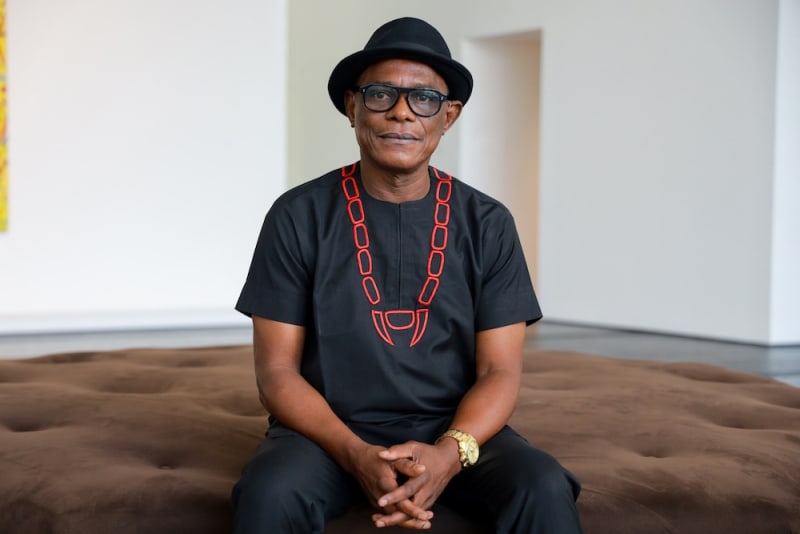Born in 1962 in Kumba, Cameroon, Samuel Fosso was raised in Nigeria and fled the Biafran War as a young boy. In 1972 he was taken in by an uncle in Bangui in the Central African Republic and in 1975, when he was just 13, he opened his Studio Photo Nationale. Alongside his commercial work he started to take self-portraits, and has continued the practice ever since. Now this work has won Fosso the Deutsche Börse Photography Foundation Prize 2023, aimed at artists and projects deemed to have made the most significant contribution to photography over the preceding 12 months.
Fosso was awarded the prize for the retrospective Samuel Fosso at the Maison Européenne de la Photographie, Paris, which was on show from 10 November 2021 to 13 March 2022, then travelled to Huis Marseille, Amsterdam, and Walther Collection, Neu-Ulm, Germany. Fosso has won £30,000, with £5000 each going to the three other shortlisted artists: Bieke Depoorter, Arthur Jafa and Frida Orupabo. The judges for this year’s award were Nathalie Herschdorfer, director of Photo Elysée, Lausanne, Switzerland; Mahtab Hussain, artist; Thyago Nogueira, head of contemporary photography at Instituto Moreira Salles, São Paulo, Brazil; and Anne-Marie Beckmann, director of Deutsche Börse Photography Foundation, Frankfurt/Main.
The voting chair was Shoair Mavlian, director of The Photographers’ Gallery, London, which is currently displaying work by all four finalists. “We are delighted to announce Samuel Fosso as the winner of this year’s prize,” says Mavlian. “His sustained exploration of self-portraiture uses a traditional, studio-based approach steeped in history, while at the same time his work remains relevant and addresses contemporary political issues of today with humour and authenticity. His work has created an extraordinary platform for Black voices and artists throughout his career.”
Exploring self-presentation and gender representation, Fosso has portrayed iconic Black figures such as Muhummad Ali, Malcolm X and Angela Davis, as well as European costumes, karate keikogi, naval uniforms and African folk costumes. His work quickly gained wider attention, winning him the first African Photography Encounters in Bamako, Mali, in 1994, and in 1997 Parisian department store Tati commissioned him to recreate an African portrait studio, alongside Malick Sidibé and Seydou Keïta. In 1999, he shot a 10-image autumn/winter editorial for Vogue Hommes International in his Bangui studio. He has, he told BJP last year, “un goût profond pour la mode” – “a deep love of fashion”.
Fosso’s work has long been recognised in the art world, and exhibited in institutions such as Museum of Modern Art, New York; Tate Modern, London; and Centre National de la Photographie, Paris. In 1997 Fosso released The Chief: He Who Sold Africa To The Colonists in 1997, depicting himself as a decorated African leader, and in 2008 he shared African Spirits, a series paying tribute to 14 political, intellectual and cultural figures from Pan-African movements and the US Civil Rights Movement. These works testify to his determination to highlight Black and African history although he told BJP; “My art is not political, I do not do politics.”
Instead he hopes to transcend political power games, he explained, “to bear witness to the past for current and future generations, to fill in the gaps in the communal narrative”. Fosso has also made works depicting alternative realities or speculative futures, such as his 2017 series Black Pope. “While the question of identity is, in certain aspects, central to my work, I would like – in a utopian way – for the cultural sector and for humanity to rise above these questions,” he told BJP. “Each person has both so many indefinable particularities and universal aspects, which we all recognise in ourselves.”
In 2014 Fosso’s home studio in Bangui was ransacked after sectarian violence, an incident discovered by chance by photojournalist Jerome Delay who, with fellow photojournalist Marcus Bleasdale and Peter Bouckaert, emergency director at Human Rights Watch, salvaged an estimated 20,000 negatives and 150–200 prints. Fosso’s cameras were stolen and the artist, who was fortunately in Paris at the time, responded by making SIXSIXSIX in 2015–16, a series of hundreds of self-portrait Polaroids. “After these wars and all the hardships I have suffered, I still have life, and photography helps me to continue on this path,” he told BJP.

